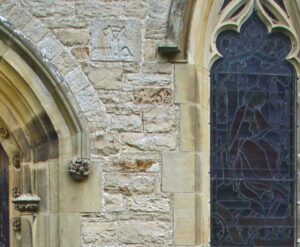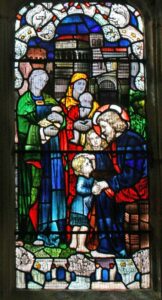 WELCOME to St Andrew’s church.
WELCOME to St Andrew’s church.
When you step inside the church PLEASE sanitise your hands and sign or check in for test and trace. We would be very grateful if you could adhere to social distancing rules and follow the arrows around the church and not enter the sections which have been roped off.
To reach the entrance you will have walked through what is reputed to be the largest parish graveyard in England. There’s over four acres of it with the new cemetery adjacent to its northern wall accessible from the north east corner of the graveyard. An ancient stone cross found in 1968 provided evidence that this area has been used for Christian worship for over 1,000 years. Sadly, that cross was stolen from the church in 1996.
Aysgarth Parish was once one of the biggest in England as it stretched to the western end of Wensleydale. By the beginning of the 17th century, however, four new parishes had been created, leaving Aysgarth to cover Carperby, Thornton Rust, Bishopdale, Thoralby, Newbiggin and West Burton.
Between 1864 and 1866 the church was completely rebuilt with proper foundations as that restored in the reign of Henry VIII was in such poor condition. The lower part of the tower is all that remains of the 16th century church. All the stained glass windows were installed after 1866, including Caroline Townshend’s Arts and Crafts portrayal of children with Jesus (above). For more about the windows click here.
According to G Bernard Wood in his book Yorkshire Villages (1971), when the church was being rebuilt in the 19th century 17-years-old Jim Peacock from Carperby was taken on as an apprentice stone sculptor at a shilling or two per week. ‘It was not long before the senior masons, recognising the skill and perfection of Jim’s work, actually went on strike until he was paid a wage commensurate with his undoubted ability,’ wrote Mr Wood.
The clock was made by William Potts of Leeds and is dated 1903. It was donated by James Clarkson Winn who then owned Yore Mill below the church. It is said that Mr Winn especially provided the clock face on the north side so that it could be seen at the mill.
INSIDE THE CHURCH – WEST END
On the left of the table with the sanitiser is the Baptistry. The impressive font was donated by Mrs J C Winn in 1913 in memory of three of her children who died in infancy.
In their book about Aysgarth church Marian and John Kirby stated: ‘The oldest part of the fabric of the church still in its original position is the west wall of the nave. It has a doorway with pointed (Gothic) arch leading from the nave into the base of the tower. The doorway and [a clasping buttress in the tower] suggest that this was the outer west wall of a simple church dating from the late 13th century.’ They estimated that the tower was added by the 14th century to house bells hence being initially called a ‘belhouse’. (P20)
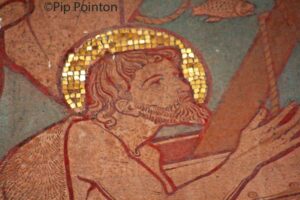 The mural on the west wall was gifted to the church by Major Rhodes of Harewood after the church was rebuilt in the 1860s. He then owned Bear Park at Carperby. (right – detail from the mural)
The mural on the west wall was gifted to the church by Major Rhodes of Harewood after the church was rebuilt in the 1860s. He then owned Bear Park at Carperby. (right – detail from the mural)
The arrows will lead you to the central aisle of the church. To the left, on the north wall, are the war memorials, commemorating the men who died in action in two World Wars and in the 1st Iraq War. See War memorials and graves.
Above the beginning of the aisle on the north side is a marble plaque in memory of a member of the Wray family, a Lieutenant in the 7th Fusiliers, who was killed at the storming of Badajoz during the Peninsula War in 1812.
Also above the central aisle are three chandeliers, made in 1889. They were originally designed to carry four oil lamps in each.
EAST END
The 18th century font which stands near the stained glass window depicting Jesus raising the son of the widow of Nain (The Doctors Window) is still used for baptisms.
The pulpit of Austrian oak was carved by Ralph Hedley of Newcastle and presented to the church in 1915 by Frank Sayer Graham of Aysgarth, in memory of his first wife. The design is 15th century Gothic in keeping with the ends of the Vicar’s Stall and the Jervaulx Screen.
The central panel illustrates the hymn ‘Lead kindly light’ and represents Jesus about to heal the man born blind (John 9:5). The panel on the right (south side) illustrates the hymn ‘Fight the good fight’ and shows St Paul pleading with his countrymen (Acts 22:22). These two hymns were Mrs Graham’s favourites.
The subject matter of the panel on the north side is a reference to the fact that Mrs Graham died on Holy Innocents Day (December 28). It is taken from Revelations 14:1-5 ‘The lamb as it had been slain’ standing on Mount Zion surrounded by glory. The fourth panel carries a dedication to Mrs Graham.
This pulpit was dedicated in 1915. The Victorian pulpit which it replaced was set on an oak base to form the Curate’s Stall which is at the west end of the organ adjacent to that donated by Mr Graham.
The organ was built by Abbot of Leeds in 1880 and rebuilt by Wood Wordsworth & Co of Leeds in 1970.
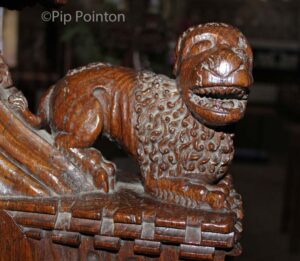 On the opposite side of the chancel from the pulpit is the Vicar’s Stall. This has two exquisitely carved bench ends including a medieval representation of a lion (right) and is believed to have been part of the Abbot’s Stall at Jervaulx Abbey.
On the opposite side of the chancel from the pulpit is the Vicar’s Stall. This has two exquisitely carved bench ends including a medieval representation of a lion (right) and is believed to have been part of the Abbot’s Stall at Jervaulx Abbey.
One theory is that the letters ‘H.M.’ in a shield with a crozier and mitre carved on one end could be the initials of Marmaduke Huby, Abbot of Fountains Abbey. On the other end is the letter ‘W’ above a hazel bush and a tun (barrel) believed to be the rebus (logo) of William de Heslington who became Abbot of Jervaulx in 1472.
The magnificent Jervaulx Screen stretches from the Vicar’s Stall to the east wall. It is said that it was originally brought from Jervaulx Abbey to St Andrew’s for safe keeping after the dissolution of the monasteries in the 16th century. Edmund Bogg in Beautiful Wensleydale (1926) stated that the screen was carried on the shoulders of 20 men over the moors to Aysgarth.
Both the bench ends on the Vicar’s Stall and the Jervaulx Screen are the work of the Ripon School of Woodcarvers and have been dated to the late 15th century.
Originally the Jervaulx Screen was installed at Aysgarth as a rood screen (separating the nave from the chancel). It was moved to its present position in 1866 to make way for choir stalls and the organ.
Walk on towards the East Window to see, on the left, the woodwork above the vestry door. Besides two mischievous imps (or devils) there is the inscription ‘A.S.Abbas anno d’m 1536’. This commemorates the rebuilding of the church during the reign of Henry VIII. Adam Sedber was the Abbot of Jervaulx Abbey at that time. In 1857 he was executed in the Tower of London for his part in the Pilgrimage of Grace.
The advowson (right to present a Rector to the living) for Aysgarth church was given to Jervaulx Abbey in 1397 and in 1423 the Abbey became Lay Rector. In 1554 Queen Mary gave the advowson to the Master and Fellows of Trinity College, Cambridge as part of their endowments. They still own the advowson, act as Lay Rector and continue to be responsible for the upkeep of the Chancel.
The altar and reredos were placed in the church in 1887 as a memorial to Henry T Robinson and his wife Elizabeth. Mr Robinson was one of the main benefactors of the restoration of the church 1865 to 1866.
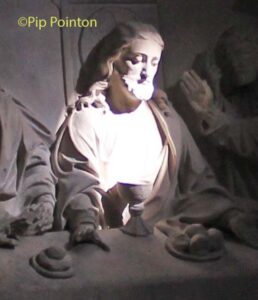 The reredos is based on the Leonardo da Vinci painting of The Last Supper. Around 10th April and 3rd September at about 3.30pm in the afternoon, if the sun is shining through one of the clerestory windows, the head of Jesus is lit up for about five minutes. (Photograph taken on 9th April 2019)
The reredos is based on the Leonardo da Vinci painting of The Last Supper. Around 10th April and 3rd September at about 3.30pm in the afternoon, if the sun is shining through one of the clerestory windows, the head of Jesus is lit up for about five minutes. (Photograph taken on 9th April 2019)
The sculpture, carved in Caen stone, is by a Roman Catholic, R L Boulton of Cheltenham, from designs by C G Wray FRIBA. The stone altar is unusual and might have been expected in a Roman Catholic rather than an Anglican church. Without a wooden top making the altar ‘officially’ a table the altar would have been illegal.
Three angels were carved on the altar front: that in the left panel is holding a shield with the letter A for Alpha; that on the right a shield with Omega; and the centre angel’s monogram is IHS (Jesus). The writing above the Last Supper ‘Ad Majoren Dei Gloriam’ means ‘To the greater glory of God’.
LADY CHAPEL
Follow the arrows into the Lady Chapel. This was furnished as a memorial to two local families: the Wrays and the Winns, and was dedicated on 28th May 1925.
Below the East Window in this chapel there is a brass plate commemorating numerous members of the Wray family including Ann Fraser who is described as ‘the heroine of Cawnpore’.
On the south wall there are two piscinas. These were placed on either side of the door in 1866 and probably came from the side chapels of the previous building.
On the left as you leave the Lady Chapel there is a bronze plaque to Lieut. Col. Alban Wilson D.S.O. of the 8th Gurkha Rifles. After he retired from the army in 1918 he wrote Trout Fishing in Kashmir which is now a very collectable book.
Also on the left is the Arts and Crafts window designed by Caroline Townshend in 1905, part of which shows Jesus blessing the children. Do take time to count the squirrels!
OUTSIDE THE CHURCH
When you leave the church turn left. On the south wall at the east end there is an upside down horn! It is believed this is from an old gravestone that was once on the floor of the church before the 19th century restoration, and would probably have commemorated a medieval horn blower in the forest of Wensleydale.
Around the corner to the east end of the church there are some other gravestones which once were on the floor of the church. These include those of an 18th century vicar of Aysgarth, the Rev John Dupont, and of his mother, Susannah.
The Dupont’s were a Huguenot family, and John Dupont’s father, Cesar, had fled from Die in France after the repeal of the Edict of Nantes in 1685. He was a calico printer, first in London and then in Middleham. He purchased Temple Farm near Aysgarth which John later inherited. There is an article about the Dupont family history by Jean Andrews in the 2020 edition of Now Then, soon to be available at the Dales Countryside Museum at Hawes.
A little further along and also leaning against the east wall is the gravestone commemorating (In Latin) Hannah Buckle of Burton as being a fertile (fecund) wife!
Sources
A Visitor’s Guide – to Aysgarth church – not available in the church due to the Covid-19 restrictions.
Yorkshire Villages by G. Bernard Wood, 1971
Aysgarth Church – Odd bits of its history and Some of its people by Marian and John Kirby, 2009. Available in the Research Room at the Dales Countryside Museum which is usually open on Mondays and Fridays. All visitors to the museum must pre-book a timed entry slot. Tel. 01969 666210 or via website.
Wanderings in Wensleydale by George Hardcastle, 1864.
Pip Pointon’s interviews and research including My personal view.
